Figures & data
Figure 1 Relationship between IL-37 expression and CD1a+ DC frequency in the tumor microenvironment. (A) Representative immunohistochemical images of IL-37 and CD1a in the same primary hepatocellular carcinoma (HCC) tumors (original magnification: ×200). (B) IL-37 expression positively correlated with the density of CD1a+ DCs in HCC tumors. (C and D) The overall survival (OS) rate and disease-free survival (DFS) rate of Patients.
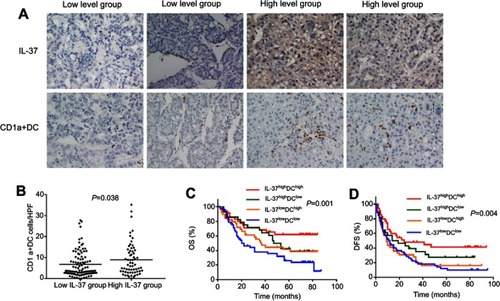
Figure 2 IL-37 recruits dendritic cells (DCs) by stimulating tumor cell-derived CCL chemokine production in hepatocellular carcinoma (HCC). (A) Stable IL-37 expression in Hep3B cells was confirmed by Western blotting. (B) The levels of IL-37 secreted by Hep3B/LV-IL37 cells and Hep3B/LV-NC cells. Data presented are from three separate experiments. (C) Numbers of DCs attracted by DMEM alone, DMEM with recombinant IL-37, supernatant of Hep3B/LV-NC and supernatant of Hep3B/LV-IL37, respectively. Data from three separate experiments are presented. (D) The expression levels of mRNA encoding CCL chemokines in Hep3B/LV-IL37 cells compared to Hep3B/LV-NC cells. Data presented are from three separate experiments. **P<0.01, NS: not significant.
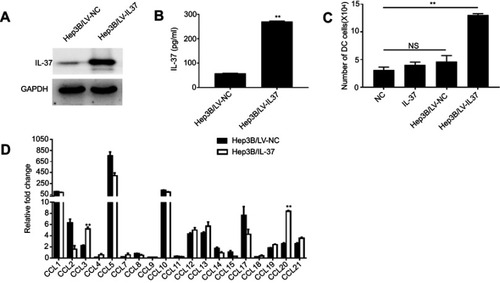
Figure 3 IL-37 indirectly enhances the ability of dendritic cedendritic cells (DCs) to induce anti-tumor immune response. DCs were cultured in DMEM alone, DMEM with recombinant IL-37, supernatant of Hep3B/LV-NC and supernatant of Hep3B/LV-IL37, respectively. (A and B) The expression levels of major histocompatibility class (MHC) class I, MHC class II, CD80, CD86 and CD40 on DCs. Data presented are from three separate experiments. (C) The expression levels of the mRNA encoding CXCL9 and CXCL10 in DCs. Data presented are from three separate experiments. (D and E) The levels of IL-2, IL-6, IL-10, IL-12, IL-12p70, CXCL10, TNF-α, interferon-α (IFN-α) and IFN-γ secreted by DCs. Data presented are from three separate experiments. *P<0.05, **P<0.01, ***P<0.001, NS: not significant.
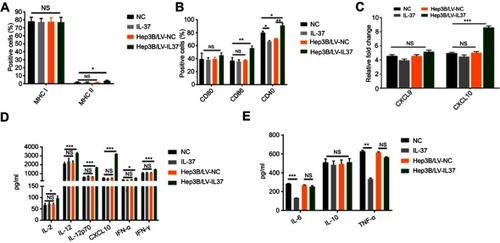
Figure 4 IL-37 indirectly strengthens the cytotoxicity of cytotoxic T lymphocyte (CTL) induced by dendritic cells (DCs). T lymphocytes were treated with DCs cultured in DMEM alone, DMEM with recombinant IL-37, supernatant of Hep3B/LV-NC and supernatant of Hep3B/LV-IL37, respectively. (A) The proliferation of T lymphocytes. (B) The levels of interferon-γ (IFN-γ) secreted by T lymphocytes. Data presented are from three separate experiments. (C and D) The proportion of IFN-γ+ CD8+T cells and IFN-γ+ T cells. (E) The cytotoxicity of T lymphocytes. Data presented are from three separate experiments. *P<0.05, **P<0.01, NS: not significant.
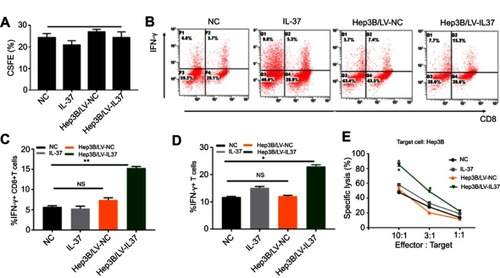
Figure 5 IL-37 indirectly promotes dendritic cell (DC) recruitment and anti-tumor function in vivo. (A) Stable IL-37 expression in Hepa 1–6 cells was confirmed by Western blotting. (B) The levels of IL-37 secreted by Hepa 1–6/LV-IL37 cells and Hepa 1–6/LV-NC cells were detected through ELISA. Data presented are from three separate experiments. (C) MTS assays indicated that overexpression of IL-37 did not significantly affect ex vivo Hepa 1–6 cell proliferation. Data presented are from three separate experiments. (D) Photographs of dissected tumors from C57BL/6 mice in the Hepa 1–6/LV-IL37 group and Hepa 1–6/LV-NC group. (E) Tumor growth curves of Hepa 1–6/LV-IL37 group and Hepa 1–6/LV-NC group. (F) The final tumor weights of Hepa 1–6/LV-IL37 group and Hepa 1–6/LV-NC group. (G–J) The expression of IL-37, the density of CD11c+DCs, CD4+T cells and CD8+T cells infiltration in murine tumors (original magnification: ×400). Data presented are from six separate experiments. **P<0.01, ***P<0.001, NS: not significant.
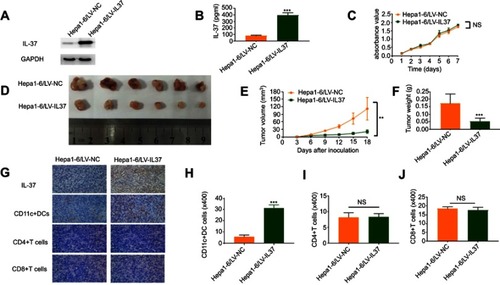
Table S1 Primers for real-time quantitative polymerase chain reaction analysis
